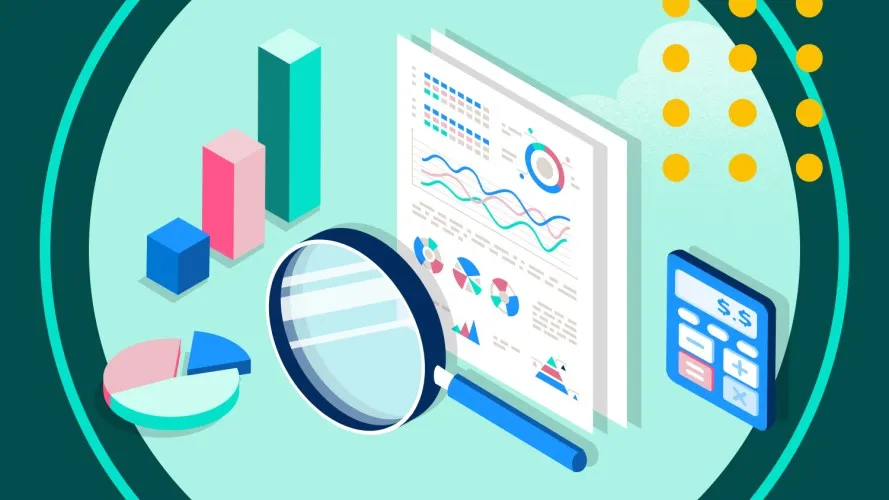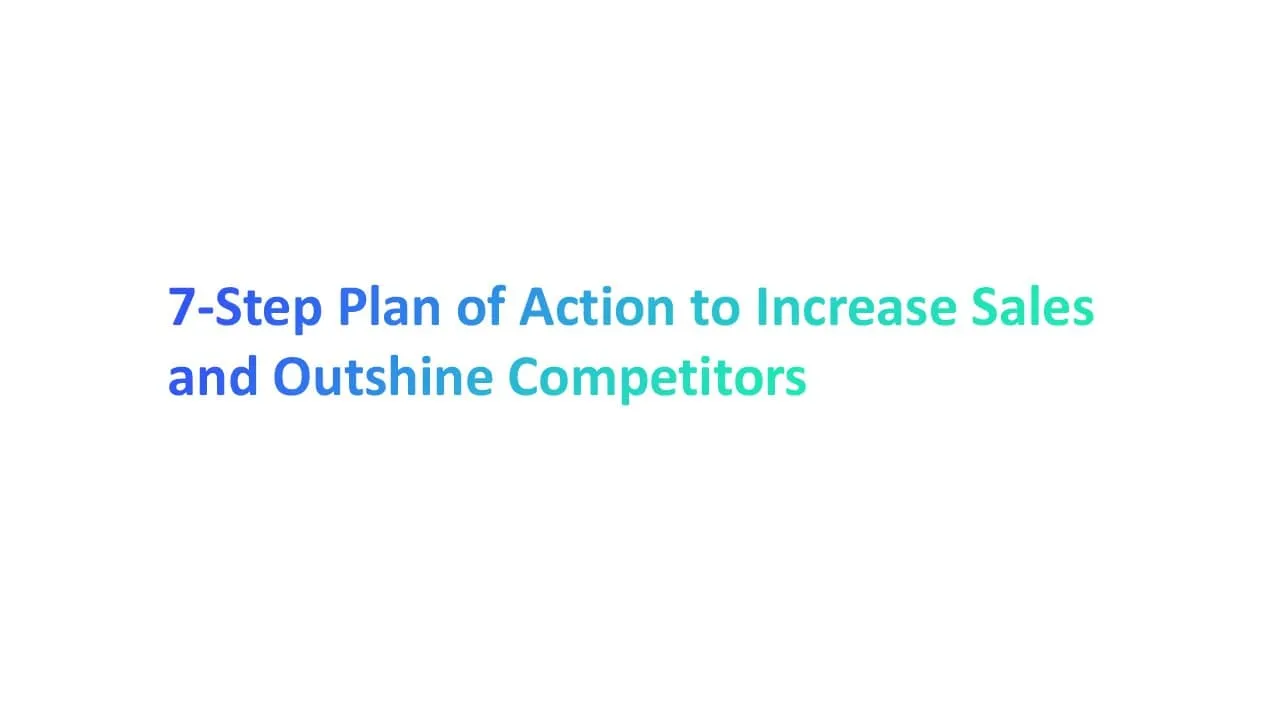Ever feel like no matter how hard your sales team works, the numbers just won’t move the way you want? You’re not alone. Many businesses hit that wall where effort is high, but results don’t follow. That’s when having a clear, structured plan of action makes all the difference.
The truth is, competitors aren’t slowing down. They’re refining their sales process, training their sales reps smarter, and using the right tools to stay ahead. Without a proven framework, it’s easy to fall behind—even with a strong product or service.
That’s why in this article, we’ll break down a 7-step plan of action to increase sales. It’s practical, easy to follow, and designed to help your sales team close more deals while outshining the competition. By the end, you’ll know exactly where to start and how to guide your team toward measurable growth.
Why Your Current Sales Strategy Isn’t Working

Many companies struggle to grow because their sales strategy is outdated or unclear. Without a structured sales plan and proper sales planning, even the best sales teams fail to hit revenue goals or build long-term customer relationships.
1. Lack of Clear Target Audience and Ideal Customer Profile
When a sales team does not define its target audience, every step in the sales funnel becomes weak. Without knowing the target customers or buyer persona, sales activities waste time and miss pain points.
- Sales leaders often rely on a broad target market instead of doing market research.
- A sales plan lays the foundation for identifying qualified leads and existing customers.
- Without clarity, sales managers push sales team members toward random sales opportunities instead of building real customer relationships.
This makes the buying process longer, reduces sales performance, and keeps sales goals out of reach.
2. Overcomplicated or Broken Sales Process
An overcomplicated sales process often confuses potential customers. Instead of guiding them through a smooth buyer’s journey, sales reps create friction in the sales stage.
- Sales managers fail to simplify the sales pipeline, which hurts business growth.
- The lack of a clear sales approach prevents closing deals at the right time.
- Sales teams that don’t streamline sales activities lose new business to competitors.
A strategic sales plan backed by proper sales planning ensures every step—from initial meeting to closing deals—aligns with company revenue goals.
3. Sales Reps Working Without Proper Training or Guidance
Sales reps need structured training to improve team performance and sales performance. Without clear direction, even motivated sales team members waste effort.
- Sales managers should focus on one-on-one meetings, cold calling practice, and role-based sales activities.
- Business leaders must ensure sales reps understand the value proposition.
- Proper coaching helps sales reps track sales quotas and improve performance measurement.
When training is missing, sales activities do not lead to qualified leads or paying customers, blocking revenue targets.
4. Misalignment Between Sales Team and Business Goals
A sales team cannot achieve success if its sales goals and revenue goals are not aligned with overall business development. Sales managers often fail to connect sales strategies with strategic direction.
- Sales activities and sales action plans must support the company business plan.
- Business leaders and marketing teams need to work with sales teams for demand generation.
- Without coordination, sales opportunities are missed, and new customers move to competitors.
A traditional business plan must work alongside an effective sales plan to ensure long-term business growth.
5. Ignoring Data and Metrics in Decision-Making
Sales performance cannot improve without tracking metrics. Many sales leaders ignore performance measurement, leaving sales reps without clear direction.
- Sales activity tracking shows where the sales funnel is leaking.
- Customer feedback and company blog insights help refine marketing strategies.
- Using data helps sales managers adjust sales action plans to achieve success faster.
Ignoring data also means missing out on free templates and tools that simplify performance tracking for inbound leads and account executives.
6. Outdated Tools That Slow Down Productivity
Sales team members cannot work efficiently with outdated tools. A modern saas company needs digital systems to support sales activities, new business, and the overall sales process.
- Without proper tools, sales reps waste hours on manual sales activity instead of closing deals.
- Sales opportunities are missed because of slow communication and weak team structure.
- New customers demand faster responses, and old tools hurt customer relationships.
To achieve success, sales leaders must invest in tools that improve sales pipeline visibility, help sales teams hit sales quotas, and save time during one on one meetings.
Build Your Plan: 7-Step Framework to Increase Sales

A clear framework gives direction to your sales action plan. By breaking it into seven steps, you can guide sales teams, set sales goals, and align every activity with your revenue goal.
1. Define Your Target Customer Profiles
Knowing who you sell to is the first step in any sales plans. A clear target profile ensures your sales reps focus on the right buyer persona instead of wasting time.
- Use market research to define your target market.
- Build detailed profiles for potential customers and existing customers.
- Link this process to product market fit so your product marketing connects with the right people.
When sales teams work with clarity, finding a qualified lead becomes much easier.
2. Set SMART Revenue Goals (Yearly, Quarterly, Daily)
Sales leaders must set a measurable revenue goal instead of vague targets. SMART goals help track success across different sales stages.
- Yearly and quarterly sales goals give strategic direction.
- Daily sales targets and sales quota keep sales reps focused.
- A revenue goal should match the marketing strategy to ensure demand generation.
This step creates accountability and shows sales managers whether the team performance is moving in the right direction.
3. Audit and Refine Your Sales Process
An effective sales plan means reviewing the entire sales process regularly. Many sales opportunities are lost because no one audits what is working or not. sales goal
- Map your sales funnel from first phone calls to closing deals.
- Use free templates to document each sales stage.
- Check which sales activities bring in new business and which create bottlenecks.
With a refined process, every sales action plan becomes smoother and more predictable.
4. Train and Enable Your Sales Team and Sales Reps
Sales reps need training, coaching, and tools to improve team performance. Without structured enablement, even a strong sales plan lays weak results.
- Run one-on-one sessions to sharpen closing skills.
- Teach how to identify a qualified lead early.
- Ensure sales managers align training with sales goals and marketing strategies.
Strong training makes sales team members more confident and improves customer relationships at every touchpoint.
5. Deploy the Right Tools and Technology
Outdated tools slow down productivity. A sales action plan should include modern systems that help teams save time and close more deals.
- CRM software to track sales opportunities.
- Automation tools to handle routine sales activities.
- Collaboration apps that connect the marketing team with sales.
These tools give sales leaders better visibility into the sales pipeline and allow faster decision-making.
6. Track Daily Activities and Key Performance Metrics
To achieve success, sales managers must measure performance at every level. Sales performance is not just about closing deals but also about consistent sales activity.
- Track phone calls, emails, and meetings.
- Compare results against sales targets and sales quota.
- Use dashboards to monitor progress toward each revenue goal.
Performance measurement ensures no sales opportunities are lost and helps adjust strategies quickly.
7. Close the Loop with Feedback and Continuous Improvement
A sales action plan should not end once sales goals are met. Continuous improvement keeps the sales funnel healthy and the sales team motivated.
- Collect customer feedback to refine the value proposition.
- Align the sales team with the marketing team to adjust product marketing.
- Use results to update sales plans and strategic direction.
This ongoing process helps sales leaders build long-term business growth instead of chasing short-term sales targets.
16 Tools That Empower Your Sales Strategy & Team
The right tools can transform how your sales team works. From automation to analytics, these platforms make it easier to streamline sales processes, boost performance, and close more deals.
1. Sales Engagement Platforms

These platforms help sales reps automate outreach, schedule follow-ups, and manage engagement at scale.
Alore.io
Alore.io helps sales reps automate outreach and follow-ups while tracking engagement in one place.
- Key Features: Automated emails, sequences, reminders, analytics.
- How to Use: Upload leads, set up campaigns, monitor performance.
- Pricing: Paid plans, usually based on team size.
- Pros and Cons: Saves time and improves outreach consistency, but may need training to master.
SalesLoft
SalesLoft supports personalized engagement at scale with cadences and activity tracking.
- Key Features: Email tracking, call recording, cadence management.
- How to Use: Build cadences, monitor engagement, track performance.
- Pricing: Enterprise-level pricing.
- Pros and Cons: Excellent for large teams, but costly for smaller businesses.
2. Customer Relationship Management (CRM) Tools

CRM platforms let sales teams track leads, manage deals, and nurture stronger customer relationships.
Salesforce
Salesforce is a robust CRM platform trusted worldwide for managing pipelines and automating sales.
- Key Features: Pipeline management, automation, analytics, integrations.
- How to Use: Organize sales pipeline, automate tasks, generate reports.
- Pricing: Subscription-based, varies by features and users.
- Pros and Cons: Highly scalable, but setup and customization can be complex.
HubSpot CRM
HubSpot CRM is user-friendly, making it ideal for small to mid-sized sales teams looking to scale.
- Key Features: Contact tracking, deal stages, reporting, integrations.
- How to Use: Add deals, log sales activities, track dashboards.
- Pricing: Free plan available; paid upgrades for advanced tools.
- Pros and Cons: Easy to use and affordable, but advanced tools are locked in higher tiers.
3. Lead Generation and Prospecting Tools

These tools help sales reps identify, research, and connect with quality leads faster.
LinkedIn Sales Navigator
Sales Navigator provides advanced filters and insights to find the right leads on LinkedIn.
- Key Features: Lead search filters, CRM sync, account insights.
- How to Use: Apply filters, save leads, engage directly on LinkedIn.
- Pricing: Monthly subscription, premium tiers available.
- Pros and Cons: Great for B2B leads, but expensive for small businesses.
ZoomInfo
ZoomInfo offers verified contacts and company data for targeted outreach.
- Key Features: Company profiles, email/phone contacts, integrations.
- How to Use: Search databases, export leads, connect with CRM.
- Pricing: Custom pricing.
- Pros and Cons: Accurate data and large database, but pricing may be high.
4. Sales Analytics and Reporting Software

These tools provide dashboards and reports that track KPIs and forecast revenue.
Tableau
Tableau delivers powerful data visualization for analyzing sales performance.
- Key Features: Custom dashboards, visual reports, forecasting tools.
- How to Use: Connect sales data, build dashboards, analyze results.
- Pricing: Subscription-based.
- Pros and Cons: Strong analytics, but steep learning curve.
InsightSquared
InsightSquared helps sales teams track KPIs and improve forecasting accuracy.
- Key Features: Forecasting, revenue reports, pipeline analytics.
- How to Use: Import CRM data, monitor trends, adjust strategies.
- Pricing: Custom pricing based on company size.
- Pros and Cons: Accurate forecasting, but not ideal for very small teams.
5. Communication and Collaboration Tools

Collaboration tools keep sales teams connected and aligned in real time.
Slack
Slack allows instant messaging and integrations for smooth sales team communication.
- Key Features: Channels, file sharing, CRM integrations.
- How to Use: Create channels for sales teams, connect with apps.
- Pricing: Free plan available, premium tiers for more features.
- Pros and Cons: Great for teamwork, but can cause message overload.
Microsoft Teams
Microsoft Teams combines chat, calls, and file sharing in one platform.
- Key Features: Video calls, chat, integration with Office apps.
- How to Use: Host meetings, share files, collaborate with teams.
- Pricing: Bundled with Microsoft 365 plans.
- Pros and Cons: Excellent for Office users, but may feel heavy for small teams.
6. Marketing Automation Platforms

These platforms streamline lead nurturing and automate marketing activities that support sales.
Marketo
Marketo automates campaigns to move leads smoothly through the sales funnel.
- Key Features: Email campaigns, lead scoring, analytics.
- How to Use: Build workflows, score leads, pass them to sales.
- Pricing: Enterprise-level pricing.
- Pros and Cons: Strong features for large companies, but complex for small teams.
ActiveCampaign
ActiveCampaign combines CRM features with email marketing automation.
- Key Features: Email automation, deal pipelines, segmentation.
- How to Use: Create email workflows, manage deals, analyze reports.
- Pricing: Affordable subscription tiers.
- Pros and Cons: Great balance of marketing + CRM, but limited enterprise features.
7. Learning and Sales Training Tools

Training platforms help sales teams improve conversations and close deals faster.
Gong
Gong analyzes sales calls and meetings to help managers coach their teams.
- Key Features: Call recording, AI insights, rep scorecards.
- How to Use: Record calls, review insights, provide coaching.
- Pricing: Enterprise-level pricing.
- Pros and Cons: Excellent insights for coaching, but setup can be complex.
Chorus.ai
Chorus.ai records and reviews sales conversations to highlight improvement areas.
- Key Features: Call recording, transcript analysis, team insights.
- How to Use: Sync with sales calls, review data, train reps.
- Pricing: Custom pricing.
- Pros and Cons: Great for feedback, but data-heavy for small teams.
8. Contract and E-Signature Management Tools

These tools simplify proposals, approvals, and signing of contracts.
DocuSign
DocuSign is a secure and widely used e-signature tool for contracts and agreements.
- Key Features: E-signatures, contract templates, compliance.
- How to Use: Upload contracts, send for signature, track progress.
- Pricing: Subscription-based, starting at basic tiers.
- Pros and Cons: Highly reliable and secure, but premium features are costly.
PandaDoc
PandaDoc streamlines proposals, quotes, and signatures with customizable templates.
- Key Features: Proposal builder, e-signatures, analytics.
- How to Use: Create proposals, share with clients, track engagement.
- Pricing: Affordable tiers for small and mid-sized businesses.
- Pros and Cons: Easy to use with templates, but limited advanced integrations.
Track and Adapt: KPI Dashboards Every Sales Leader Needs

A sales plan is only as good as the data behind it. Tracking key performance indicators (KPIs) helps sales leaders understand progress, spot problems early, and make smarter decisions for business growth.
1. Sales Revenue
Sales revenue is the most direct measure of how much money your sales team is bringing in. It shows if your sales strategies and sales action plan are leading to actual results.
- Helps sales leaders measure business growth against revenue goals.
- Tracks the success of campaigns, sales reps, and product marketing.
- Useful for comparing actual revenue to sales targets.
Formula to measure: Total Revenue = Number of Units Sold × Price per Unit
2. Lead Conversion Rate
This metric tells you how many potential customers move from leads to paying customers in your sales funnel.
- Identifies weak points in the sales process and sales stage.
- Helps sales managers train sales team members for better results.
- Shows if your marketing strategies are bringing qualified leads.
Formula to measure: Lead Conversion Rate = (Number of Conversions ÷ Number of Leads) × 100
3. Sales Pipeline and Forecasting
A sales pipeline dashboard gives a clear view of where each deal is in the buyer’s journey. Forecasting helps predict revenue targets and demand generation.
- Tracks progress of deals at every sales stage.
- Highlights sales opportunities for closing deals faster.
- Supports better sales planning and setting of realistic revenue goals.
Formula to measure: Forecasted Revenue = Σ (Deal Value × Win Probability)
4. Activity Tracking (Calls, Emails, Meetings)
Activity dashboards track how many phone calls, emails, or one on one meetings sales reps are making. It’s a measure of team performance and effort.
- Lets sales managers see if sales activities match sales goals.
- Ensures sales reps follow the sales action plan daily.
- Helps connect activity levels with closing deals.
Formula to measure: Activity Rate = Total Sales Activities ÷ Number of Sales Reps
5. Sales Cycle Length Dashboard
This shows how long it takes from the initial meeting to closing deals. Shorter cycles usually mean a more effective sales approach.
- Identifies bottlenecks in the sales funnel.
- Helps optimize sales activities and reduce delays.
- Supports better forecasting and business development.
Formula to measure: Average Sales Cycle = Total Days to Close Deals ÷ Number of Deals Closed
6. Customer Acquisition Cost (CAC)
CAC tells you how much money it costs to get one new customer. It combines both marketing strategy and sales expenses.
- Helps balance revenue targets against marketing team budgets.
- Shows if product market fit is strong enough to reduce cost.
- Used by sales leaders to set smarter sales quotas.
Formula to measure: CAC = Total Sales & Marketing Costs ÷ Number of New Customers
7. Customer Retention and Churn
Retention shows how many existing customers stay, while churn shows how many leave. Both are vital for long-term business growth.
- Highlights if sales teams are building strong customer relationships.
- Shows if sales goals are too focused on new customers instead of retention.
- Connects directly to revenue goal stability.
Formula to measure:
Retention Rate = ((Customers at End – New Customers) ÷ Customers at Start) × 100
Churn Rate = (Lost Customers ÷ Customers at Start) × 100
8. Sales Rep Performance
This measures how well individual sales reps and sales team members perform against sales quotas and sales targets.
- Tracks deals closed, sales activities, and sales performance quality.
- Helps sales managers identify training needs for account executives.
- Ensures alignment with overall sales plan and company goals.
Formula to measure: Sales Rep Performance = (Actual Sales ÷ Sales Quota) × 100
Conclusion
You’ve made it this far, which already puts you a step ahead of most businesses that never take the time to rethink their approach. But knowledge alone won’t create results—consistent action will. Every small step you take from today will compound into a bigger shift tomorrow.
So, instead of waiting for the “perfect time,” choose one strategy, commit to it, and put it into practice right away. Progress doesn’t happen overnight, but it does reward those who start before their competitors do. The future of your business isn’t written yet—you’re holding the pen.





.jpg)



